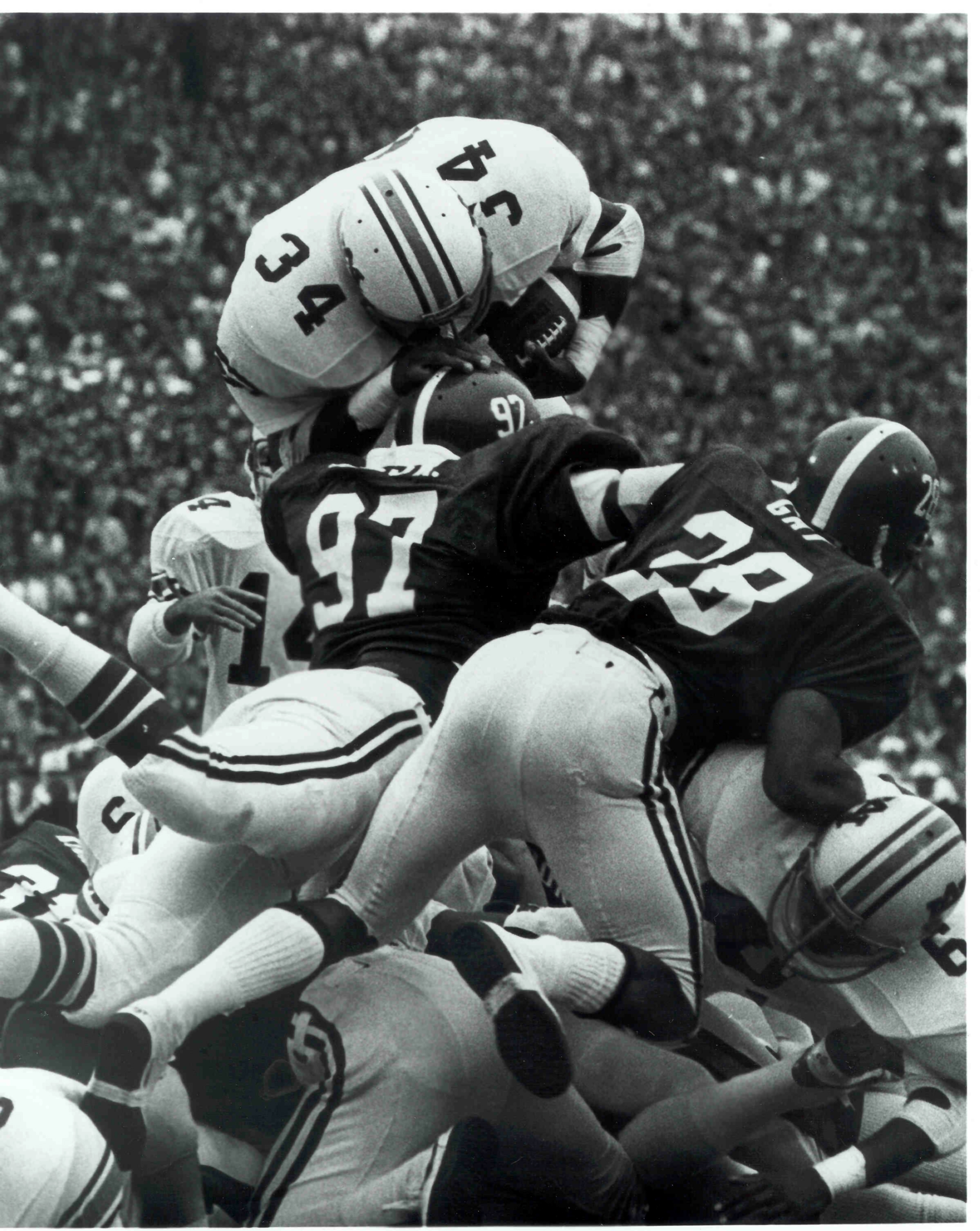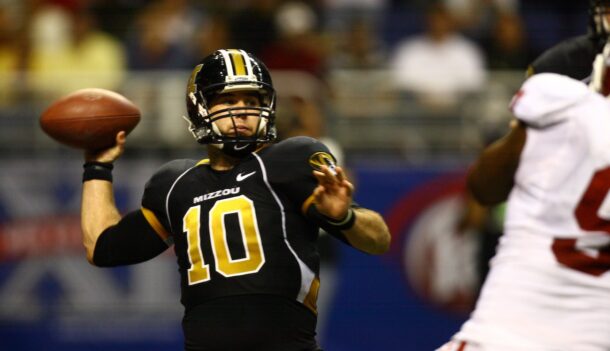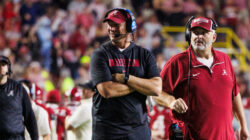
The SEC is known for great defenses, physical line play … and dazzling running backs. It’s fitting, then, that nearly every SEC team has at least one back who could be considered an all-time great. In fact, six of the conference’s 12 Heisman winners have been running backs.
What better time than the offseason to define the best runners in conference history? Let’s get started with the best from each team in the SEC West.
Alabama: Derrick Henry
There have been a multitude of formidable runners in Alabama history, but one stands just a nose above the rest. In Tuscaloosa, titles are king, as the Tide claimed 12 titles before their first Heisman Trophy. While Henry wasn’t the first Heisman-winning Tide back, or the first to cap his season with a national title (Mark Ingram was both), he was by far one of the most dominant running backs in SEC history.
Henry’s 2,219 rushing yards in 2015 is the best in SEC history, and sixth in college football history. His 28 touchdowns were also an SEC record. Though players like Shaun Alexander and Bobby Humprey had more longevity, Henry set the career rushing mark at Alabama (3,591 yards) in only three years, and neither of those players took home the Heisman or won a title. Seems pretty simple when put like that.
Arkansas: Darren McFadden
Darren McFadden was a beast. Just like Henry, he was able to do more in three years than the vast majority of college running backs can do in four. He had three consecutive 1,000-yard seasons and sits at third on the SEC career rushing rankings with 4,590 yards, ahead of names like Bo Jackson and Emmitt Smith.
McFadden made the most of his time in Fayetteville, becoming one of six SEC players to rush for 200 yards in three games. McFadden’s crown jewel is arguably the best performance by a running back in SEC history, as his record of 321 yards vs. South Carolina still stands. Though his teams at Arkansas were never in the title hunt, he had one of the most impactful performances by a running back in SEC history – a 206-yard romp against eventual national champion LSU, which led to one of the Tigers’ two losses that season. If Henry has the best single-season in SEC history, McFadden has to be near the top on a per-year basis, as he ran for basically an entire season worth of yards (727) in three career games against South Carolina alone.
Auburn: Bo Jackson
Bo knows greatness, and few have had as much staying power as the dynamic back. Jackson is the Tigers’ only Heisman winner at the RB position and his feats on the football field were enough to back up his off-field mythology. Jackson ran over defenders for four years at Auburn. He ranks fifth in SEC history and capped his college career with a 1,786-yard season in 1985 that was good enough for that aforementioned Heisman trophy.
Bo always seemed to shine in the spotlight, and no moment was bigger than the 4th-and-goal play that became known as “Bo Over the Top.” In Bear Bryant’s last Iron Bowl as a coach, Jackson sent him home with a loss – pretty decent for a player that the Bear wanted to play tight end.
LSU: Kevin Faulk
This is one of the hardest battles of any SEC school, with both Kevin Faulk and Leonard Fournette making a compelling case as the GOAT. Fournette’s 1,953-yard 2015 season was a thing of beauty, but the talented ballcarrier couldn’t stay healthy, and he struggled mightily against Alabama.
Faulk, on the other hand, was the model of consistency at LSU. The multi-faceted back played heavy snaps during his four-year tenure, during which he was a three-time First Team All-SEC selection, SEC Freshman of the Year, and a First Team All-American as a returner. Faulk ranks first in LSU history, and fourth in SEC history with 4,557 rushing yards and he also chipped in 600 receiving yards. His 6,833 all-purpose yards were fourth in NCAA history and first in SEC history when he retired, and his mark of 46 TDs remains third all-time.
Faulk’s signature moment came during the 1996 season opener against Houston, when the dynamic back led LSU from down 34-14 at halftime to a 35-34 win with his 246 yards and two TDs.
Mississippi State: Anthony Dixon
Anthony Dixon is as underappreciated a back as there has ever been in the SEC. He was the driving force behind Sylvester Croom’s teams, and he helped to engineer their turnaround 8-5 season in 2007. Though “Boobie” did more losing than winning, his four years of consistency resulted in career marks of 3,994 yards and 42 touchdowns, good enough for No. 10 and No. 8 in SEC history, respectively. Though he had an extra year, Dixon actually finished with the same amount of TDs as Mark Ingram and Derrick Henry.
Dixon’s 2009 season, his only under Dan Mullen was a special one, and it included his highest single-season marks in yards (1,391) and yards per carry (5.4). That 2009 team wasn’t very good, as starting QB Tyson Lee threw 4 TDs and 14 interceptions, and the team finished at 5-7. Because of their limited offense, Dixon was counted on again and again to deliver and he continued to produce, specifically in his 252-yard outburst against Kentucky, which was the highest total of any State player at the time.
Ole Miss: Deuce McAllister
Much like Kevin Faulk, McAllister was the model of consistency at Ole Miss. He set school records for rushing yards (3,181), carries (616), touchdowns (38), and 1,000-yard seasons (3) without having any of the top-10 single-game rushing performances in Rebels history. He was a huge part of the Rebels going to four consecutive bowl games and finishing the year ranked twice.
McAllister became the New Orleans Saints’ all-time leading rusher in similar fashion: consistently and under the radar. He made two All-SEC teams and two Pro Bowls, and only one of his pro or college teams finished below .500.
Texas A&M: Darren Lewis
Darren Lewis didn’t play a single snap as a member of the SEC, but the conference will gladly take him on as a stepson, as he was clearly the best Aggie runner in history. Even though A&M’s history includes a Heisman winner at the position in John David Crow, Lewis’ numbers pretty much blow his out of the water due to the evolution of the game over time.
Responsible for the two best seasons in Aggie history, Lewis led the nation in rushing yards with 1,691 in 1990 and the Southwest Conference with 1,692 yards in 1988. In fact, Lewis’ 5,012 rushing yards place him first all-time in SWC history and would’ve put him second to only Herschel Walker in the SEC.
Lewis capped his college career, and his All-American senior season in style, by beating Heisman winner Ty Detmer’s BYU Cougars 65-14 in the Holiday Bowl. All of these accomplishments shouldn’t be overlooked just because they happened in the Southwest and not the Southeast.
Cover photo of Bo Jackson courtesy of Auburn Athletics.
A former resident of both Baton Rouge and the heart of Crimson Tide country, Will Ogburn handles multimedia content and news coverage for Saturday Down South.







